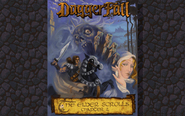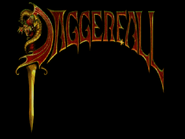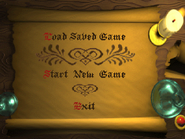- For other uses, see Dagger.
- "Prepare to experience your new obsession."
- ―Tagline
The Elder Scrolls II: Daggerfall is the second installment in The Elder Scrolls series. It is set in the Iliac Bay area of High Rock and Hammerfell during the Third Era of Tamriel's history, ending in an event called the Warp in the West. The plot of the game revolves around the Mantella and Totem of Tiber Septim, which together can activate the Numidium.
Gameplay
The key feature of Daggerfall, as in all The Elder Scrolls games, is the freedom the game offers to players. Players are free to play the game in any style, from an honorable knight to an evil assassin. Players are also free to stray from the main quest at any time and can choose not to do it at all, and instead explore around or join factions.
Daggerfall features a spell creation system where, through the Mages Guild, players can mix a variety of different effects, such as fire damage and levitation, into custom spells. The game will then automatically generate the mana cost of the spell based on the power of the effects chosen. Daggerfall shipped with several spell effects that did not function correctly, or simply did not function at all, namely the transformations.
Other features include an equipment enchantment system (similar in concept to the spell creation system), the ability to buy houses and ships, vast amounts of clothing and equipment, dynamic political relationships between kingdoms, the ability to become a vampire, werewolf, or wereboar, and the combat system, which utilized mouse movement to determine the direction of sword swings in melee combat.
The political system is supported by a net of guilds, orders, and religions, all with unique tasks and quests. Joining and contributing to these facilities allows the player to raise ranks and achieve a higher reputation in the game world. According to the player's reputation, characters in Daggerfall will react differently (for example, over time nobles will be more well-mannered with the Player character if they are a high-rank Knight or Royal Guard).
Daggerfall featured nudity prominently, both on characters (particularly witches and temple priestesses) and on the player character's portrait when they removed all of their equipment. Options to turn off both nudity and blood are available.
Setting
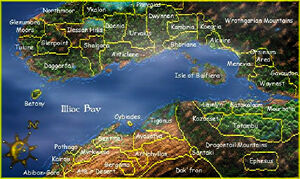
Map of Iliac Bay in Daggerfall.
Daggerfall, like the other games in The Elder Scrolls series, takes place on the continent of Tamriel. In Daggerfall, the Hero of Daggerfall may travel within the High Rock and Hammerfell provinces of Tamriel. The journey through these realms is made difficult by a wide range of formidable enemies, the strongest of which are the Daedra.
Daggerfall is the second to largest Elder Scrolls game to date, surpassed only by The Elder Scrolls: Arena, featuring a game world which Bethesda has claimed to be "the size of Great Britain," or approximately 209,331 square kilometers (80,823 square miles),[3] with over 15,000 towns, cities, villages, and dungeons for the player's character to explore.[source?] According to Todd Howard, Elder Scrolls programmer, the game's sequel, The Elder Scrolls III: Morrowind is 0.01% the size of Daggerfall,[source?] but it should be noted most of Daggerfall's terrain was randomly generated. Vvardenfell, the explorable part of the province of Morrowind in the third game has 15.54 square kilometers (6 square miles).[source?] The Elder Scrolls IV: Oblivion has approximately 41.44 square kilometers (16 square miles) to explore[source?] and the entire map of The Elder Scrolls V: Skyrim is 38.33 square kilometers (14.8 square miles).[source?] In Daggerfall, there are 750,000+ non-player characters (characters) for the player to interact with,[source?] compared to the count of around 1000 characters found in Morrowind and Oblivion. However, the geography and the characters in these later games are much more detailed.
An auto-map was implemented to help players navigate through the lengthy tombs and ancient underground fortresses. There is a search bar to type in locations and travel the player could select if they wanted to sleep in inns, camp out, use a horse, etc. Players have to visit approximately 6–8 areas in order to finish the game, although a total of 47 areas are present. A limited array of building blocks were used to construct the towns and dungeons, causing some reviewers to complain about the game's monotony. In 2002, Morrowind, the third game in the series, responded to this issue with a smaller, more detailed world with unique-looking cities and characters with greater individuality.
Story
- Main article: Main Quest (Daggerfall)
- "You wake and look around the room. Some hours ago, you were in a boat, en route to Daggerfall, when a storm of supernatural strength boiled over the Iliac Bay like a malefic creature. Your boat was destroyed, but you managed to swim through the churning water to a promontory rock. There you found a cave and escaped the fury of the storm. You had only just lit a small fire when a mudslide sealed you within. Your fear of being buried alive calmed when you saw the corridor leading out of the cavern. Perhaps there is a way out of this cave after all. Once free of the cave, you can begin the Emperor's quest."
- ―Intro, after character creation
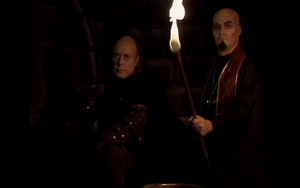
The Emperor Uriel Septim VII and chancellor Ocato in the introduction cinematic.
Daggerfall is a city in the Breton homeland of High Rock. The player is sent here at the personal request of the Emperor. He wants the player to do two things. Firstly, the player must free the ghost of the late King Lysandus from his earthly shackles. Secondly, the player must retrieve a letter from the Emperor to a Blades spy in the court of Daggerfall. The letter reveals that Lysandus' mother, Nulfaga, knows the location of the Mantella, the key to resurrecting the first Numidium. The Emperor wants his spy to force Nulfaga into revealing the location of the Mantella so that the Blades can finish the reconstruction of the Numidium. Through a series of mishaps and confusions, the letter fell into the hands of an orc by the name of Gortworg. Gortworg, not knowing what the Mantella is, consults Mannimarco, the King of Worms (the leader of the Necromancers). During this time, the Underking, who originally destroyed the first Numidium because of its misuse by Tiber Septim, is recuperating deep within a tomb of High Rock, after expending so much energy destroying it the first time. In order for the player to give the Mantella to anyone, the player must kill king Lysandus' murderer and put his ghost to rest. After accomplishing this, the power of the Mantella restores the Underking's power.
Endings
Daggerfall has five different endings:
- If the Hero gives the Mantella to the Underking, he absorbs its power, passes into eternal rest, and creates a large "magicka free" area around himself.
- If Gortworg is victorious, he uses the Numidium to destroy the Imperial forces and the "Bay Kings," the "rulers" of the several provinces of the Iliac Bay. The Underking arrives shortly thereafter to destroy the first Numidium once and for all, losing his own life in the process. Gortworg then succeeds in creating Orsinium, a kingdom of Orcs.
- If the Blades are victorious, they succeed in recreating the first Numidium and use it to defeat the Bay Kings, defeat the Orcs, and to unite all the provinces of Tamriel under the Empire once again.
- If one of the Bay Kings wins (any of them), they use the first Numidium to defeat all the other kings just before the Underking destroys it and himself.
- If Mannimarco receives the Mantella, he uses it to make himself a god.
Bethesda also cut one ending before release. Mentioned within The Daggerfall Chronicles, the time-limit to use the Totem of Tiber Septim was removed and allowed the player to keep it:
- If the Hero activates the Mantella themself while in possession of the Totem of Tiber Septim, the Numidium will slay the Hero, go out of control, and be destroyed by Imperial forces.
Continuity
Since Daggerfall had five very different endings, the writers of The Elder Scrolls series had to be creative when writing the sequel. It is revealed in books in the sequel The Elder Scrolls III: Morrowind that at the end of Daggerfall, an event known as the "Warp of the West" or "The Miracle of Peace" had occurred, that is, due to the fact that in order to retrieve the Mantella, the Hero of Daggerfall must enter Aetherius (a spirit realm), a disruption was caused in space-time, due to the fact that one of the very Gods of Aetherius (Akatosh) is the dragon god of time. Therefore, all of the endings of Daggerfall occurred simultaneously: the Kingdoms of Betony, Sentinel, and Wayrest are victorious, the "Bay Kings" and the Imperial forces are defeated by the Orcs, who then create their own kingdom of Orsinium, all of Tamriel is united under the Empire once again, the King of Worms becomes a god and another incarnation becomes the leader of the Order of the Black Worm, and the Underking is reunited with his heart.
The Agent then disappears from the region for the forseeable future as well, hinted later in Oblivion as dead via The Warp in the West. However, in Oblivion, treasure hunters claim to be hunting for treasure on behalf of Orsinium and Gortworg.
Planned content
- Originally it was planned for the player to have sex with characters, but it was cut out in the development. There remains plenty of unused text in the game's code.
- Daggerfall was planned to have an expansion, which instead became a standalone game released as the spin-off An Elder Scrolls Legend: Battlespire in 1997.[4]
Gallery
External links
- The Elder Scrolls official Daggerfall site
- Free official download, from The Elder Scrolls official site, or install via Steam.
- The Elder Scrolls II: Daggerfall on Wikipedia.
References
| Main Series | |
|---|---|
| |
| Spin-offs | |
| General | |
| Travels | |
| Online | |
| Daedric War: | |
| Season of the Dragon: | |
| Dark Heart of Skyrim: | |
| Gates of Oblivion: | |
| Legacy of the Bretons: | |
| Shadow Over Morrowind: | |
| Legends | |
| Strategy Guides | |
| Books | |
| Merchandise | |


